Districts of Tanzania
As of the 2012 census,[1] the 30 regions of Tanzania were divided into 169 districts (Swahili: wilaya).
 |
|---|
| This article is part of a series on the politics and government of Tanzania |
|
|
|
|
|
|
In 2016 Songwe Region was created from the western part of Mbeya Region.[2][3]
Districts are each administered by a district council. Cities are separately administered by their own councils, and while administratively within a region, are not considered to be located within a district. The districts are listed below, by region:
Ten most populated districts
- Kinondoni Municipal Council, Dar es Salaam Region
(1,775,049 inhabitants) - Temeke Municipal Council, Dar es Salaam Region
(1,368,881 inhabitants) - Ilala Municipal Council, Dar es Salaam Region
(1,220,611 inhabitants) - Geita District Council, Geita Region
(807,619 inhabitants) - Sengerema District Council, Mwanza Region
(663,034 inhabitants) - Muleba District Council, Kagera Region
(540,310 inhabitants) - Kahama District Council, Shinyanga Region
(523,802 inhabitants) - Nzega District Council, Tabora Region
(502,252 inhabitants) - Lushoto District Council, Tanga Region
(492,441 inhabitants) - Moshi District Council, Kilimanjaro Region
(466,737 inhabitants)
Arusha Region
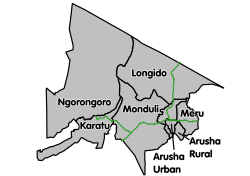
The district and city councils and populations of the Arusha Region as of the 2012 census:
- Meru District Council 268,144[4]
- Arusha City Council 416,442
- Arusha District Council 323,198
- Karatu District Council 230,166
- Longido District Council 123,153
- Monduli District Council 158,929
- Ngorongoro District Council 174,278
Dar es Salaam Region
See also: Dar es Salaam Region
The municipal councils of Dar es Salaam as of the 2015, along with their populations (2012 census):
- Ilala Municipal Council 1,220,611
- Kinondoni Municipal Council 1,775,049
- Temeke Municipal Council 1,368,881
- Kigamboni Municipal Council (created in 2015)
- Ubungo Municipal Council (created in 2015)
Dodoma Region

The district and municipal councils of the Dodoma Region as of the 2012 census, along with their populations:
- Bahi District Council 221,645
- Chamwino District Council 330,543
- Chemba District Council 235,711
- Dodoma Municipal Council 410,956
- Kondoa District Council 269,704
- Kongwa District Council 309,973
- Mpwapwa District Council 305,056
Geita Region
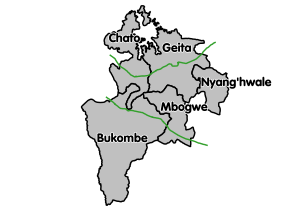
The district councils of the Geita Region as of the 2012 census, along with their populations:
- Bukombe District Council 224,542
- Chato District Council 365,127
- Geita Town Council & Geita District Council 807,619
- Mbogwe District Council 193,922
- Nyang'hwale District Council 148,320
Iringa Region
The district, municipal, and town councils of the Iringa Region as of the 2012 census, along with their populations:
- Iringa District Council 254,032
- Iringa Municipal Council 151,345
- Kilolo District Council 218,130
- Mafinga Town Council 51,902
- Mufindi District Council 265,829
Kagera Region

The district and municipal councils of the Kagera Region as of the 2012 census, along with their populations:
- Biharamulo District Council 323,486
- Bukoba District Council 289,697
- Bukoba Municipal Council 128,796
- Karagwe District Council 332,020
- Kyerwa District Council 321,026
- Missenyi District Council 202,632
- Muleba District Council 540,310
- Ngara District Council 320,056
Katavi Region
The district and town councils of the Katavi Region as of the 2012 census, along with their populations:
- Mlele District Council 282,568
- Mpanda District Council 179,136
- Mpanda Town Council 102,900
Kigoma Region

The district, municipal, and town councils of the Kigoma Region as of the 2012 census, along with their populations:
- Buhigwe District Council 254,342
- Kakonko District Council 167,555
- Kasulu District Council 425,794
- Kasulu Town Council 208,244
- Kibondo District Council 261,331
- Kigoma District Council 211,566
- Kigoma-Ujiji Municipal Council 215,458
- Uvinza District Council 383,640
Kilimanjaro Region

The district and municipal councils of the Kilimanjaro Region as of the 2012 census, along with their populations:
- Hai District Council 210,533
- Moshi District Council 466,737
- Moshi Municipal Council 184,292
- Mwanga District Council 131,442
- Rombo District Council 260,963
- Same District Council 269,807
- Siha District Council 116,313
Kusini Pemba Region of Zanzibar
The districts of the Kusini Pemba Region in Zanzibar as of the 2012 census, along with their populations:
- Chake Chake District 97,249
- Mkoani District 97,867
Kusini Unguja Region of Zanzibar
The districts of the Kusini Unguja Region in Zanzibar as of the 2012 census, along with their populations:
- Kati District 76,346
- Kusini District 39,242
Lindi Region
The district and municipal councils of the Lindi Region as of the 2012 census, along with their populations:
- Kilwa District Council 190,744
- Lindi District Council 194,143
- Lindi Municipal Council 78,841
- Liwale District Council 91,380
- Nachingwea District Council 178,464
- Ruangwa District Council 131,080
Manyara Region
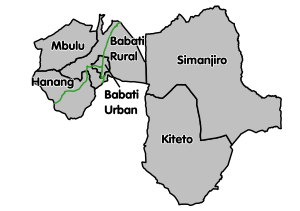
The district and town councils of the Manyara Region as of the 2012 census, along with their populations:
- Babati Town Council 93,108
- Babati District Council 312,392
- Hanang District Council 275,990
- Kiteto District Council 244,669
- Mbulu District Council 320,279
- Simanjiro District Council 178,693
Mara Region
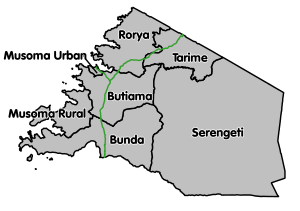
The district and municipal councils of the Mara Region as of the 2012 census, along with their populations:
- Bunda District Council 335,061
- Butiama District Council 241,732
- Musoma District Council 178,356
- Musoma Municipal Council 134,327
- Rorya District Council 265,241
- Serengeti District Council 249,420
- Tarime District Council 339,693
Mbeya Region
The district, city, and town councils of the Mbeya Region as of the 2012 census, along with their populations:
- Busokelo District Council 96,348
- Chunya District Council 290,478
- Kyela District Council 221,490
- Mbarali District Council 300,517
- Mbeya City Council 385,279
- Mbeya District Council 305,319
- Rungwe District Council 339,157
Mjini Magharibi Region of Zanzibar
The districts of the Mjini Magharibi Region in Zanzibar as of the 2012 census, along with their populations:
- Magharibi District 370,645
- Mjini District 223,033
Morogoro Region
The district and municipal councils of the Morogoro Region as of the 2012 census, along with their populations:
- Gairo District Council 193,011: http://www.gairodc.go.tz/
- Kilombero District Council 407,880: http://www.kilomberodc.go.tz/
- Kilosa District Council 438,175: http://www.kilosadc.go.tz/
- Morogoro District Council 286,248:http://www.morogorodc.go.tz/
- Morogoro Municipal Council 315,866: http://morogoromc.go.tz/
- Mvomero District Council 312,109: http://www.mvomerodc.go.tz/
- Ulanga District Council 151,001: http://www.ulangadc.go.tz/
- Malinyi District Council 114,202: http://www.malinyidc.go.tz/
- Ifakara Township Council 121,806: http://www.ifakaratc.go.tz/
Mtwara Region
The district, municipal, and town councils of the Mtwara Region as of the 2012 census, along with their populations:
- Masasi District Council 247,993
- Masasi Town Council 102,696
- Mtwara District Council 228,003
- Mtwara Municipal Council 108,299
- Nanyumbu District Council 150,857
- Newala District Council 205,492
- Tandahimba District Council 227,514
Mwanza Region
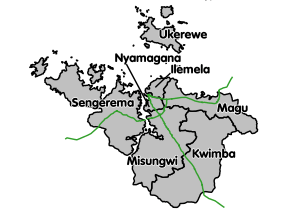
The district and municipal councils of the Mwanza Region as of the 2012 census, along with their populations:
- Ilemela Municipal Council 343,001
- Kwimba District Council 406,509
- Magu District Council 299,759
- Misungwi District Council 351,607
- Nyamagana Municipal Council 363,452
- Sengerema District Council 663,034
- Ukerewe District Council 345,147
Njombe Region
The district and town councils of the Njombe Region as of the 2012 census, along with their populations:
- Ludewa District Council 133,218
- Makambako Town Council 93,827
- Makete District Council 97,266
- Njombe District Council 85,747
- Njombe Town Council 130,223
- Wanging'ombe District Council 161,816
Pwani Region
The district and town councils of the Pwani Region as of the 2012 census, along with their populations:
- Bagamoyo District Council 311,740
- Kibaha District Council 70,209
- Kibaha Town Council 128,488
- Kisarawe District Council 101,598
- Mafia District Council 46,438
- Mkuranga District Council 222,921
- Rufiji District Council 217,274
Rukwa Region
The district and municipal councils of the Rukwa Region as of the 2012 census, along with their populations:
- Kalambo District Council 207,700
- Nkasi District Council 281,200
- Sumbawanga District Council 305,846
- Sumbawanga Municipal Council 209,793
Ruvuma Region
The district and municipal councils of the Ruvuma Region as of the 2012 census, along with their populations:
- Mbinga District Council 353,683
- Songea District Council 173,821
- Songea Municipal Council 203,309
- Tunduru District Council 298,279
- Namtumbo District Council 201,639
- Nyasa District Council 146,160
Shinyanga Region

The district, municipal, and town councils of the Shinyanga Region as of the 2012 census, along with their populations:
- Kahama Town Council 242,208
- Kahama District Council 523,802
- Kishapu District Council 272,990
- Shinyanga District Council 334,417
- Shinyanga Municipal Council 161,391
Simiyu Region
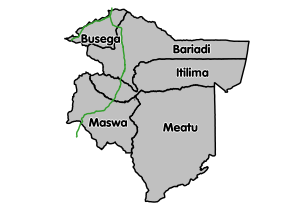
The district councils of the Simiyu Region as of the 2012 census, along with their populations:
- Bariadi District Council 422,916
- Busega District Council 203,597
- Itilima District Council 313,900
- Maswa District Council 344,125
- Meatu District Council 299,619
Singida Region

The district and municipal councils of the Singida Region as of the 2012 census, along with their populations:
- Ikungi District Council 272,959
- Iramba District Council 236,282
- Manyoni District Council 296,763
- Mkalama District Council 188,733
- Singida District Council 225,521
- Singida Municipal Council 150,379
Songwe Region
The district and municipal councils of the Songwe Region are:
Tabora Region
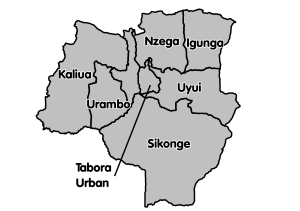
The district and municipal councils of the Tabora Region as of the 2012 census, along with their populations:
- Igunga District Council 399,727
- Kaliua District Council 393,358
- Nzega District Council 502,252
- Sikonge District Council 179,883
- Tabora Municipal Council 226,999
- Urambo District Council 192,781
- Uyui District Council 396,623
Tanga Region
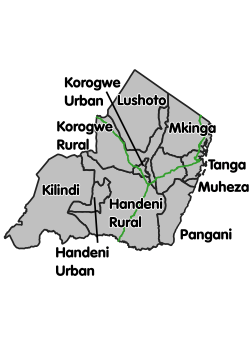
The district, city, and town councils of the Tanga Region as of the 2012 census, along with their populations:
- Handeni District Council 276,646
- Handeni Town Council 79,056
- Kilindi District Council 236,833
- Korogwe Town Council 68,308
- Korogwe District Council 242,038
- Lushoto District Council 492,441 (Usambara Mountains)
- Muheza District Council 204,461
- Mkinga District Council 118,065
- Pangani District Council 54,025
- Tanga City Council 273,332
See also
References
- Population Distribution by Administrative Units, United Republic of Tanzania, 2013 Archived May 2, 2013, at the Wayback Machine
- Mwakyusa, Alvar (4 February 2016). "Songwe is new region - with four districts". Daily News. Archived from the original on 5 February 2016. Retrieved 21 February 2017.
- "Welcome to Mbeya Region". Mbeya Regional Commissioner Office. Archived from the original on 2017-02-22. Retrieved 21 February 2017.
- Population Distribution by Administrative Areas: 2012 PHC